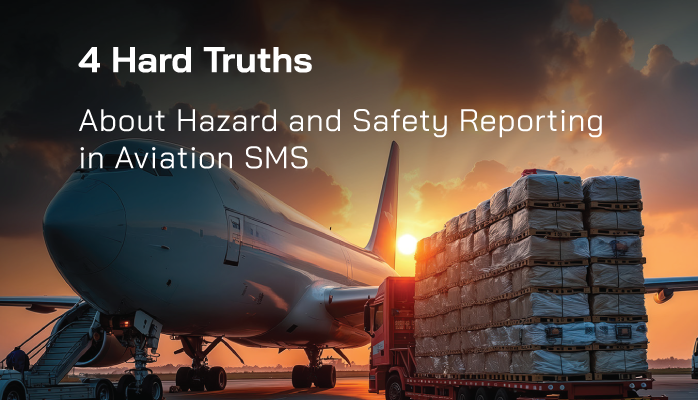Safety Reporting Process Will Make or Break an Aviation SMS

You could also say that lack of hazard and safety reporting in an aviation safety management system (SMS) can break a company.
Hazard reporting is critically important to any aviation service provider if it wants to benefit from its investment in the required and voluntary SMS. It’s equally important that aviation safety professionals have an open dialogue about what the important discussion points are and what problems are endemic to the aviation SMS.
Hazard reporting is dependent on a healthy safety culture. When you have a strong safety culture, your hazard reporting quality and metrics will naturally improve.
Related Articles on Hazard Reporting
- Indicators of Good Hazard Reporting Culture
- How to Develop a Hazard Reporting System in Aviation SMS [With Free Checklist]
- Best Practices for Hazard Reporting in Aviation SMS - With Examples
The most obvious benefits hazard reporting provides your aviation SMS are:
- It is the first barrier against avoiding dangerous situations;
- It is the primary way for identifying new threats; and
- A fantastic way to assess whether or not exiting risk controls are functioning how they should.
How satisfied are you with hazard reporting in your safety program? Here are 4 hard truths about hazard reporting in aviation safety programs.
1 – No Hazard Reporting, No Aviation SMS
Hazard reporting is the foundation of any aviation SMS. The majority of Safety Assurance risk management processes depend on it. Without hazard reporting:
- The bureaucratic backbone of safety management, such as processes, policies, etc. is just a showpiece;
- You cannot practice risk management because there’s nothing to manage or very little;
- You will have a hard time identifying hazards, avoiding risks, and mitigating consequences; and
- You will not know how to train employees to best meet the safety needs of your company.
No matter which aspect of your aviation SMS you analyze, it will either depend directly on hazard reporting or will be useless without it. Especially early in aviation SMS implementations, it’s essential that safety managers put many resources towards developing a performant hazard reporting culture.
In fact, if you really want to see whether an aviation SMS is actually performing or just looks good on paper, the first place you should look is at hazard reporting. A quick test for a good safety reporting culture is how many reports an aviation service provider receives each month AND the quality of those reports.
For every one hundred employees, a performing safety reporting metric is ten reports/month. I would also look at what types of reports have been submitted. How many close calls? Does the operator only have:
- Accidents;
- Incidents;
- Irregular occurrences; and/or
- Potentially unsafe conditions?
Don't get me wrong. These are all great safety reports, especially the "irregular occurrences" and "potentially unsafe conditions." But how many close calls are in your database? There are safety cultures that do not report close calls because they grew up with the saying: "No harm, no foul."
Related Aviation Hazard Reporting Articles
- What Good Hazard Reporting Process Look Like in Mature Aviation SMS
- 10 Most Important Hazard Reporting Forms Aviation SMS
- How to Manage Hazard Reports in Aviation SMS [With Free Resources]
Close Calls Must Be Sent to Safety Reporting System
Safety cultures that discourage or neglect to encourage employees to report all close calls will be among the last to realize benefits from the aviation SMS. Close calls are important for the SMS' safety risk management (SRM) and safety assurance (SA) risk management processes to work according to the design.
As management gains the ability to detect conditions that lead to these "close calls," management can subsequently develop procedures that will mitigate the manifestation of hazards leading to "The Accident." We all know "The Accident" is coming. We don't know when, how, or where. But we do know "why." The Accident will occur because our risk controls failed or we neglected to identify and report hazards.
Unless "close calls" are reported, management can not put these safety hazards through the proper reactive or proactive risk management processes. As management gains data from reported safety concerns from both reactive and proactive risk management processes, management will gain the ability to benefit from predictive risk management activities.
SMS is a process. In order to benefit from the process, all you have to do is "work it." It does not take much effort to understand the cycle of:
- design the system and monitor; and
- fix and monitor; or
- redesign and monitor.
In order to fix or redesign a system or process in the most efficient manner possible, an aviation SMS must have all potential hazards identified and reported. Close calls may represent a significant portion of valuable data points that will eventually improve the system.
Related Aviation Risk Management Articles
- 5 Indicators of Reactive or Proactive Safety Culture in Your Aviation SMS
- From Reactive to Proactive Risk Management in Aviation SMS
- How to Practice Reactive, Proactive, and Predictive Risk Management in Your Safety Program
Why Close Calls Are Discouraged From Reporting System
Safety cultures that discourage reporting close calls are not optimal. Why do managers discourage reporting close calls? Here are a few reasons I've seen:
- Managers don't want extra "paperwork;"
- Managers don't know how to manage these types of "no harm, no foul" safety reports;
- Managers don't want to draw unnecessary attention to their area of operations;
- Managers don't want to feel as if they don't have control in front of other managers or peers.
Managers who don't have time for paperwork is a common report from safety managers. This tells me that either the aviation service provider's:
- risk management processes are crippling them; or
- risk management documentation tools are too cumbersome or inadequate; or
- managers need more training.
For managers who don't know the company's risk management processes for dealing with close calls, this is obviously a training issue. This may be the manager who was always on his phone or in the hallway talking during SMS training. We've all seen this.
There are managers who can
- "Never really get away from it all and focus on SMS training" during scheduled SMS training courses, or
- not find the self-motivation or foresight to see how SMS benefits their company and the manager.
2 – Hazard Reporting Saves Money

Profits can be built around hazard reporting. I’m surprised that this fact doesn’t come up as often as it should. But hazard reporting will save every company money that works the process. I'm not saying that you should start spending exorbitant amounts of money on SMS tools, training, and process management. There is the law of diminishing returns for the amount spent versus expected returns on investment. This is a business decision. The development of additional controls does not have to happen overnight. Again, SMS is a process, but you need data to help work the process.
Many managers don't have effective processes to put all issues through their risk management processes. This is commonly due to a lack of tools and/or training on tools. An SMS database allows aviation service providers to define and practice repeatable risk management processes on a much larger scale than:
- spreadsheet or paper data management strategies;
- disparate point solutions requiring copy/pasting from one system to another;
- separate audit system and risk management point solutions.
If the safety manager gets ten safety reports within the last hour on Friday, will the safety manager be able to easily initiate preliminary risk management process on these safety reports, such as:
- perform quick analysis;
- assess the risk;
- determine a deadline; and
- determine who should manage the reported safety issue; and
- assign the issue (communication)?
You may think that this will never happen to you. But I have seen it happen not on a Friday, but the day before a very important regulatory audit. Let's say this airline had a disgruntled employee who disagreed with the goals and objectives of the SMS. In this case, there were actually twelve reported safety concerns and not ten. However since the safety manager had a good SMS database, she was not phased. The disgruntled employee thought he would bury the safety manager in work by sending the safety manager straight to "SMS documentation hell." All I could do was smile, and I still smile when I remember this because she was using our SMS database.
Related Aviation SMS Database Articles
- What Is an Aviation Safety Database
- 5 Most Important Things to Know Before Buying Aviation SMS Database
- Pros and Cons of In-House SMS Database and Off-the-Shelf-Solutions (COTS)
How to Use Hazard and Safety Reporting Processes to Identify Opportunities
Hazard reporting and safety reporting feed the safety assurance risk management processes as "risk monitors" against both identified and emerging hazards that could potentially cause harm to the organization. On the flip side of this coin, smart business managers will recognize that these same processes can be used to identify opportunities to make the company more competitive and profitable.
This last point is never stressed enough when implementing aviation SMS. Why use hazard reporting processes for only identifying opportunities for harm? Because this is what the regulations focus on. An aviation SMS implementation is an opportunity to reduce losses by identifying and reporting safety hazards as they manifest themselves during operations.
The smart business culture will take SMS to the next level by engaging employees in improving operational quality and identifying opportunities to become more profitable.
For many companies, effective hazard reporting processes and proactive safety cultures will save (and potentially earn) them millions. Just think:
- How costly was the accident that could have been avoided?
- How much revenue is made because of consumer confidence in the reliability of a company?
- How much money is generated by inspiring investor confidence?
- How much money is saved by avoiding costly litigation?
The physical financial ramifications of hazard reporting – such as avoiding costly crashes – are straightforward. The more conceptual financial ramifications, like company shares and public opinion, are a bit harder to understand. Nonetheless, losing investor and consumer confidence is undoubtedly the most costly. Just two incidents for Malaysia Airlines in 2014 essentially bankrupted the company.
All these problems are avoided and significantly mitigated when companies focus time, energy, money, and resources on maximizing hazard reporting metrics and improving their hazard reporting cultures. Companies risk wasting their valuable resources when they lack the ability to:
- efficiently manage reported hazards;
- monitor hazard reporting metrics; and
- address substandard safety reporting performance.
Having a "performing" safety culture is not a regulatory requirement. However, an aviation SMS is expected to regularly monitor safety performance and measure continuous improvement or lack of improvement. Without adequate tools and processes to monitor safety reporting performance, there will be no effective detection of substandard safety reporting performance.
In short, SMS performance monitoring is required to guide the safety culture and safety reporting metrics toward optimal performance.
Related SMS Performance Monitoring Articles
- How to Monitor Aviation SMS' Safety Culture Performance
- 4 Pillars | How to Conduct Safety Performance Monitoring and Measurement
- How to Monitor Aviation SMS Performance - Safety Chart
3 – Needs These Three Aviation SMS Training Programs

Hazard reporting in aviation SMS doesn’t happen by itself. It will not magically work itself out. Even if management is “nice” and makes a concerted effort to push the hazard reporting culture, it’s not enough.
Quality hazard reporting needs the right type of aviation SMS training. You probably wouldn’t let a teenager drive your car without receiving training on how to do so, and there’s no reason companies should let employees operate in extremely risky environments without being able to recognize what to watch out for.
Here are three areas of risk management training that every employee needs to give them the confidence, awareness, and skill set to properly report safety concerns:
- Reactive Risk Management Training;
- Training course covering the difference between hazards and risks; and
- Hazard identification training.
4 – How You Build Safety Culture
In aviation SMS, a mature safety culture is intimately tied to a strong hazard reporting culture. You could make the argument that quality safety culture arises from quality hazard reporting cultures.
But clearly, you can’t have a successful safety culture without having a strong reporting culture as well. Hazard reporting is a basic tenant of safety culture because both reactive and proactive reporting necessarily implies that:
- Employees are involved in the SMS;
- Employees are aware of hazards and vigilant for current safety concerns; and
- Employees respect safety management as a means of creating a safe, productive work environment.
Moreover, hazard reports give safety managers the information they need to reinforce safety culture on the bureaucratic side of the SMS as well.
Related Aviation Safety Culture Articles
- What Is Safety Culture in the Aviation Industry?
- How to Build Safety Culture in Aviation SMS
- 5 Ways to Constantly Improve Safety Culture
Final Thought: 3 Ways to Increase Safety Reporting Culture
We can discuss all day why hazard and safety reporting in SMS is important, but it’s extremely useful to also know how to influence it. Here are 3 ways to increase the quality of SMS safety reporting processes:
- Make reporting as easy as possible, such as with SMS database software, offline reporting access, and no/minimal manual, handwritten reports;
- Give regular recognition and feedback for top hazard reporters and critically important safety report submissions; and
- Keep an open discussion about reported safety issues that include discussing specific details of the issue without blame (no finger-pointing).
The best scenario is that employees are comfortable discussing their mistakes and other employees’ mistakes without defensiveness, but with the sole goal of improving safety.
A sincere, inviolate non-punitive reporting policy assures employees that your aviation SMS is designed to enhance the safety of all stakeholders. Non-punitive reporting policies should be reviewed on an annual basis to ensure they remain relevant to your organization.
Reducing the friction of the safety reporting process minimizes excuses employees may give themselves for not reporting safety concerns. Major challenges to your safety culture are the use of bad reporting tools and cumbersome risk management processes. When employees have multiple ways to report safety concerns, your SMS should see more reports. If there are no more reports, then you need to evaluate your:
- safety culture;
- hazard identification and reporting training; and
- management's historical treatment of reported issues.
Whenever employees have no visibility into the SMS, there will exist a lack of trust. They may believe the SMS is there to "catch someone doing something wrong." Transparency into the processes gains trust from the employees. When they get immediate feedback from their reported safety issues, they feel management is responsive to reporters' actions to improve the "system."
An SMS database allows real-time visibility into what is being done about an employee's reported safety concerns. Furthermore, it closes the feedback loop and allows employees to monitor their reported safety issues.
If your company has clunky SMS tools, there are low-cost commercially available SMS databases that will make your SMS more responsive to employees' safety reports. And there is a lot more. An SMS database can manage all SMS documentation requirements and not just safety reports.
If you need tools, please watch these short demo videos to see whether we are a good fit.
Live SMS Pro Demo
If it looks like we can help you or if you have questions, sign up for a live demo.
Last updated in April 2025.










